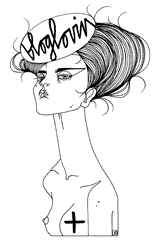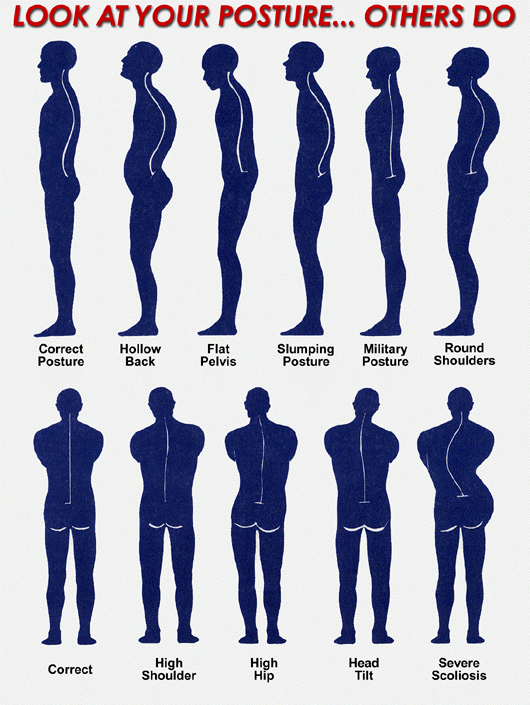
|
Day 1 - Deportment @ Monday, November 21, 2011 Day 1 - Deportment & Communication deportment [dɪˈpɔːtmənt] n the manner in which a person behaves, esp in physical bearing [from French déportement, from Old French deporter to conduct (oneself)
*means we didn't learn it in class (or maybe not yet) Good Posture means... - Head erect with chin parallel to the floor. Feel the coat hanger - Shoulders back and dropped into a relaxed position. - Chest high. - Stretch long through the waist with stomach in. Don't let your weight settle down on your hips. - Tuck buttocks under by tipping the pelvis slightly forward and up. - Knees relaxed, not locked. - Elbows slightly bent, palms turned in. Standing - Stand up tall, like you have a coat hanger inside your top, holding your body vertically. - Suck in your stomach and ass, puff out your chest (but not too much, you aren't a gorilla XD). - Chin up, but not too much - Smile - Place your feet about 2 inches apart. Place the toe of the right foot even with the left arch. - Rest most of the body weight on the front (left) foot. - Raise heel of right foot so that only the ball of the foot is on the floor. Bend right knee slightly. - Rotate right heel in toward the left foot until it is at a 45° angle. The heel of your left foot is now almost touching your right instep. - Shift your weight comfortably back onto your right foot so that both feet support you. Your weight should be evenly distributed on both hips. - Check to see hips are turned slightly in the direction right foot is pointing. - Keep your shoulders and head facing forward. If you prefer, reverse the above steps so that your right foot is in front. One side will feel more comfortable than the other, but practice both so you can change your stance from time to time when standing for long periods. Arms- Always keep your elbows in close to your sides. Press the forearm of one arm lightly against your waist with palm up and fingers relaxed. Allow your other arm to hang freely at your side. - Or extend both forearms gracefully across the waist, resting the thumb of one hand in the palm of the other. Curve your fingers into a relaxed position. - Thirdly, you can allow both arms to hang easily at your sides with your wrists just brushing the body. Walking - Same as standing, but you're moving - Chin up, look ahead, not down - Don't pound the pavement - lift your feet, try to float - Note: the noise is 95% the heels, and 5% you - Lift your thigh slightly. Don't lead with your shoulders. - For a feminine walk, the space between your steps should be about the length of your foot. Too long a stride is masculine, too short is mincing. - On each step your heel should touch the floor first, then quickly shift the weight forward to the entire foot as you take the next step. Keep your feet close to the ground when you lift them. - Arms should hang relaxed at your sides with palms toward the thighs as they swing forward to the front of your body. Shoulders should be relaxed and elbows close to your sides. - Keep your toes pointed straight ahead and place your feet directly to the side of an imaginary line running down the center. Sitting 1. Approach the chair holding your best posture. Turn so your back leg brushes against the chair seat. 2. Slide one foot back 2-3 inches under the chair seat. 3. Lower yourself into the seat keeping your head erect and your back straight. Most of your weight should be carried by the thigh of your back leg. 4. Ease down into the seat gracefully...don't flop. 5. For deeper seats or upholstered chairs where you can't slip your foot under, sit as above but on the edge of the seat. When seated, lift your weight slightly and slide back. While seated, arrange your legs at a slight angle. Cross your legs at the ankles or knees. Rest your hands in your lap, palms up. (remember palms shows openness) To rise from a sitting position, simply reverse the above steps. Lift yourself gracefully in one easy motion letting your back leg muscle do the work. Don't push up using the chair arms. Notes: - mini skirt, sit a bit more forward in the chair to keep your knees discreetly covered - full skirt, place your hand behind you and grasp the center back of the skirt. Bring the skirt out to one side before you sit down Getting out of a Car Getting In: 1. Stand close to the car facing the same direction the car is pointing. 2. Place the foot nearest the car on a line just in front of the seat, and the outside foot one step forward. 3. Lower yourself with your weight carried on your thigh muscles until your head is clear of the car roof and sit on the outer edge of the seat. 4. Swing your knees to the front and bring your feet inside the car. 5. Arrange your skirt. Getting Out: 1. Lift your derriere slightly off the seat and straighten your skirt, pulling it gracefully to cover your knees. 2. Slide to the outer edge of the seat, knees together. 3. Place the foot that is nearest the door on the curb, bending the other leg at the same time to keep the knees close together. 4. Step out with the other foot and lift yourself from a sitting position with your thigh muscles, keeping your back straight. Up & Down the Stairs 1. Balance is key. Use your best posture. Don't bend your head to look at the stairs. Glance down with your eyes only. 2. Don't lead with your head. Move with your body erect, head up, weight on the back foot and placing your full weight on the front foot as the torso comes over it. 3. Place your entire foot on the step without letting your heel hang over the edge. (step diagonally on the step) 4. Take your time! 5. On narrow stairs, place your feet sideways. 6. When getting on buses, trains, etc., face in the direction the vehicle is moving and hold the handrail. Step up with your feet sideways on the steps. If wearing a long dress/skirt, use both hands. Bend your knees slightly and grasp each side of the skirt a few inches above the knees. Lift the skirt until it is just above the ankles. If it's tight e.g. mermaid tail, bend your knees and grasp the fabric of the skirt a few inches above the knee. Lift the skirt until it is just above your ankles and glide up or down the stairs Entering & Leaving Entering: 1. Avoid bursting into a room. Hesitate for a moment in the doorway, compose yourself, and glance quickly around to note names, faces, and the environment. Before you step into the room, you should know where you are going and to whom you will be speaking. 2. Smile. 3. If there is a door, grasp the knob with your hand. If the door opens into the room to the right, use your right hand, and vice versa. Keep your arm straight and open the door as you walk forward. Step sideways and reach behind you with the opposite hand to grab the inner door knob. Step backwards to close the door without turning your back on the room. Leaving: 1. Leave a good impression. Smile. 2. If there is a door, walk up with your back to the door, reach behind and grasp the knob. Straighten your arm and walk forward opening the door behind you. Step to the side, grasp the outer knob and back out of the room, pulling the door closed. Picking Things Up When bending to pick up objects, keep your back straight and bend from the knees. Keep your head up. - not only graceful (and there's no opp for anyone to stare at your ass), it protects your back from injury. Handbags Don't carry your handbag under your arm like a football, as this can ruin the lines of your dress. Don't carry your handbag down by your side with your arm fully extended, as this can not only bump your leg repeatedly, but also become an obstacle for passers-by. Handbag slip your hand through the handle from the outside and let the handle rest on your wrist. Turn your palm up with fingers relaxed. Place your wrist lightly against your waist so the purse rests on the flat of your hip. Clutch hold the bottom of the bag in your hand, resting it on the length of your index and middle fingers. Rest your hand against your hip, letting the bag relax to an angle. Shoulder bag rest the strap on your shoulder. to stop bag from swinging when you walk, grasp the center of the front strap to hold it in place. Don't push down on the top of the bag. Don't slip the strap over your head and wear the bag criss-crossing the body. Gloves How to put on gloves: 1. Slip your hand down the glove and gently ease it on by grasping the cuff. 2. If the gloves are snug, smooth the fingers on gently to avoid splitting the seams. 3. Never pull by the cuff, as this can stretch your glove. Instead smooth the glove with upward strokes from the fingers up the arm. 4. Never push between the fingers. Smooth the fingers with upward strokes until the glove is comfortable. How to remove gloves: 1. Pull gently at the tip of each finger until you can hold the fingertips of the glove. 2. Grasp all the fingertips of the glove in the opposite hand and pull gently to ease your hand out. 3. Never grasp the cuff to pull your gloves off, as this will turn them inside out. How to hold your gloves: 1. After removing your gloves, ease away any creases and reshape them.
2. Fold the thumb of each glove in and press the two gloves together, palms in, with fingertips and cuffs even. 3. With the cuff end facing out, fold the gloves over the side of your hand between the forefinger and thumb. Hold them in place with your thumb. 4. If the gloves are long, fold them in half lengthwise and place the folded part out, then hold between the forefinger and thumb. |

Hi. I'm Charlie. Capricorn. ISFJ. Engaged. From CA, studying events in Melbourne. This is a blog about food, photography, hot chocolate & cupcakes, events, shopping, and the occasional beauty product review. Want to contact me? Click here to email me.  Follow Me? 

 Sticky Posts Public Relations Archives August 2011 September 2011 October 2011 November 2011 December 2011 January 2012 February 2012 March 2012 April 2012 May 2012 June 2012 July 2012 August 2012 September 2012 October 2012 November 2012 December 2012 January 2013 February 2013 March 2013 April 2013 May 2013 June 2013 July 2013 August 2013 September 2013 October 2013 November 2013 December 2013 January 2014 February 2014 March 2014 April 2014 May 2014 June 2014 July 2014 Thanks to... Original Base Design
Base Editor - Erma97 Basecoder - detonatedlove Original Header Design teacakehouse Coding Assistance (IT) Kitty_meow Disclaimer Any resemblance to real or fictitious names, identities, characters, persons, whether living or dead, settings, situations, or other information, is purely coincidental and unintentional. Bloggers.com Bloglovin' |













